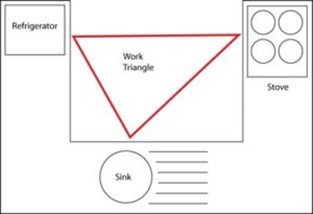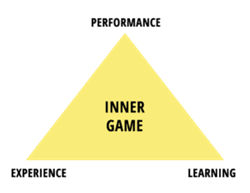Assessing the Value of Experience in the Workplace: Performance vs. Years Worked
Often, we have candidates who emphasize their qualifications and value by stating how many years they have worked in an industry. We often hear a candidate tell us they have 25+ years of experience or even 35+ years of experience. While we appreciate every person who has committed to serving in their industry, the number of years they have been a part of that industry may equate to considerably less value than someone who has been in the industry half as long. The only way to assess the value in years is to find out not only if they showed up on gameday but also who their teammates were and what position they played. Did they surround themselves with people and companies who were continually improving their game, or did they do the opposite?

The Work Triangle: Applying Efficiency Principles to Career Growth and Performance
Those of you familiar with kitchen layout and design might know the Work Triangle as the recommended distance and layout between the sink, stove, and refrigerator. Efficiency is the triangle’s main goal, as it keeps all the major workstations near the cook without placing them so close that the kitchen becomes cramped. The work triangle is also designed to minimize traffic within the kitchen so the cook isn’t interrupted or interfered with while working. If your kitchen is not designed with this in mind, your performance when cooking could be altered. You may even get frustrated at times, which ultimately might reduce your interest in cooking.

Timothy Gallwey’s Inner Game Work Triangle: Experience, Learning, and Performance in the Workplace
The blog The Systems Thinker has an article by author Timothy Gallwey from his best-selling book for the workplace centered around his “Inner Game” approach. Timothy Gallwey started as a sportswriter helping coaches and athletes achieve their best performance. He then proceeded to take his theories into the business world. Gallwey’s workplace triangle is made up of experience, learning, and performance.
If you ask a group of business owners how they equate the success of their employees, it is typically unanimous they would value performance over practice all day long. Actions in the three areas of time, quality, and budget are how we measure performance in each role.
The only way to up your performance to coincide with an increase in value and opportunity is through practice and learning. Your marketability has little or nothing to do with how many years you participated or what you might think or feel you deserve in opportunity or monetary compensation.
Gallwey explains that so many companies and individuals get tunnel vision and focus strictly on performance. Leaders don’t create the workplace triangle by balancing an individual’s expected performance while leveraging the person’s experience and up-to-date learning as it relates to performance—not just of the individual but for the whole team.
Gallwey states, “Every game is composed of two parts: an outer game and an inner game. The outer game is played in an external arena to overcome external obstacles in the way of reaching external goals; the inner game focuses on internal obstacles as well as internal goals.”
Overcoming Internal Obstacles for Improved Career Performance and Growth
To master the inner game, an individual must get rid of the following:
- The assumption that “they already know”
- The assumption that learning means remediation
- Fear of being judged
- Doubt
- Trying too hard to learn and to appear learned
Too often, during an interview, a candidate is sitting in front of us because they don’t assume and are not afraid to ask for help but get judged, ignored, or forced to take an unnecessary risk by their supervisor. They want out. They want to be with a company, working with a team that values their ability to apply what they have learned with their interest and willingness to continue to learn for increased performance.
Building an Optimal Learning Environment for Improved Business Results and Employee Growth
The companies we work with that value an employee with the ability to get rid of assumptions, doubt, and fear and offer them a safe environment to ask questions and get professional answers are the companies that are attracting and keeping the top talent.
Gallwey ends his article with, “The best managers will provide what support and resources they can to the effort and will make it their mission to shape their workplace into an optimal learning environment. The payoff will be improved business results and a corporate culture that attracts employees who equally value growth in capabilities.”
Are you showing up for the game or mastering the inner game?
To Years that Count,
Suzanne Breistol,

